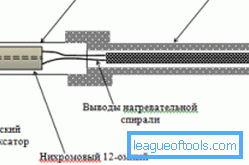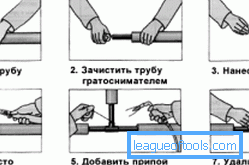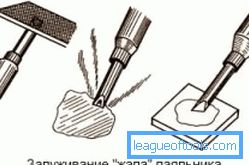How to use a soldering iron
Anyone knows what a soldering iron is. But not everyone uses it often. How to learn to use a soldering iron?

For home needs, a 40-watt soldering iron will be sufficient.
Soldering is not a difficult process. This is an ordinary event for almost any person. The main thing is to know how to use a soldering iron.
Soldering technology

Types of twisted wires
Brazing is the bonding of metals with the help of a low-melting metal melt. This low-melting metal is called solder. For soldering, it is necessary to heat the metals being joined at the joining point to the melting point of the solder. Only under this condition the solder melt is able to fill the contact gap between the metals and penetrate into their volume. Thus, there is a fairly strong bond of metals, both mechanical and electrical.
In the process of soldering, the most popular is the alloy of tin with lead, in which the tin content can vary from 20 to 90%. The best results are shown by solders of the type POS-40 or POS-60 (the numbers indicate the percentage of tin content). These solders begin to melt at temperatures of 230 and 180ºC. In some cases, tin-lead solder is used with the addition of bismuth (POSV-33), which melts when heated to 130ºС.

Scheme of a soldering iron.
For the soldering of aluminum wires, special alloys based on aluminum having a significantly higher melting point should be used. Tin-based solders are sold in the form of rods or wire 0.5-2 mm in size. In the case of soldering wires of small cross section or parts, preference is given to wire solder, since it is easier to work with it.
In most cases, soldering is impossible without cleaning the metal surface from the oxide film. For its destruction using a special substance - flux. Rosin is used as a flux for soldering copper products or products made from copper alloys. When heated at the site of soldering flux protects the metal from the influence of the atmosphere. In solder wires, rosin is usually incorporated into the wire. Experienced solders to speed up soldering do without flux, and use soldering acid to clean the metal surface. For convenience, the flux is used in different forms. For example, the flux may be a solution of rosin in alcohol. Rosin of the LTI-120 brand is used in especially critical cases.
Back to table of contentsSoldering various metal products

The procedure for the soldering of copper pipes.
Copper products or copper alloy parts usually do not cause soldering problems. They can be easily soldered using tin and rosin-based solder. Silver and silver-plated products can be soldered in the same way as copper, however, in order to improve the reliability of the connection, it is recommended to use special tin-lead solder with a silver additive.
Steel products and metals coated with zinc are brazed with rosin very badly. The position corrects the soldering acid, which destroys the oxide film. Alloys for heating devices (including nichrome) can be soldered only with the help of special fluxes. Among traditional remedies, ordinary aspirin can become effective when used instead of a special flux. Aluminum products, alloys based on aluminum and stainless steels cannot be soldered with rosin. For their soldering use specific means (effective use of concentrated phosphoric acid) and special alloys as solder.
Back to table of contentsFeatures of the choice of a soldering iron

Foil soldering.
For soldering, you need a main tool - a soldering iron. Any soldering iron includes a body with a handle; heating element (most commonly used conventional spiral); copper sting and wire to connect to the electrical network. The heating element is closed by a casing, and inside it is located and fixed a copper sting. It provides heating of the entire sting when energized. The sting has a cylindrical part, which is fixed inside the heater, and a working section (tip of the sting).
The shape of the working part of the tip can be in the form of a scapula, as well as a conical or needle-shaped form. Usually set the sting in the form of a scapula with a bevel of 45º to one side or with sections on both sides. The working section of the tip can be straight or bent down, depending on the place of soldering.

Scheme of capillary soldering of copper.
The soldering iron is selected first of all by its power. Naturally, the higher the power of the heating element, the higher the temperature of heating of the soldering section and the greater the volume of the material being heated. Soldering irons for domestic needs are available in power from 20 to 125 watts. Under normal conditions for the repair of household appliances, the use of soldering irons of 25 or 40 W is considered optimal. Such soldering irons are recommended for beginners.
The sting of almost all soldering irons is made of copper, which is associated with its high thermal conductivity. The diameter of the tip has a noticeable effect on the soldering parameters. There are mainly two types of sting: the usual diameter of 4-5 mm and small-sized - 2-3 mm. Of course, when soldering small electrical circuits, it is advisable to use a low-power soldering iron with a small-sized copper tip.
Back to table of contentsPreparatory work

Soldering soldering tip.
To properly use a soldering iron, you need to prepare for soldering. First you need to prepare your workplace. Working with a soldering iron implies high temperature and electrical voltage. Therefore, the socket for turning on the soldering iron should be located within reach of the hand for quick disconnection if necessary. The soldering iron itself must be located on a convenient stand that provides quick installation and removal of the soldering iron. However, he should not touch the heated table or other objects.
Such a stand for a soldering iron of various shapes is sold in finished form. You can do it yourself. The self-made stand has a textolite base in which two racks of steel wire or a rod with a diameter of 4-5 mm are fixed. Such a rack has an M-shaped look and is fixed with both legs at the base. The soldering iron is installed in the central recess of both racks simultaneously, usually in a horizontal position.
For convenience, small tanks for solder and rosin should be provided. It is better if it will be small metal jars of small height, but of sufficient diameter. Capacities should be fixed so that they do not move during the soldering process.
The soldering tip before work requires preparation. First you need to inspect the surface of the work area. If, after previous use, flaws are noticeable on the surface of the sting, then it is necessary to remove all surface defects (nodules, notches, etc.) by file. If the tip of the stinger has lost its shape, then you should sharpen it with a file and restore the 45º bevel.

Pipe soldering scheme.
It is very important to cover the tip of the stinger with solder (tin). It is produced as follows. The soldering iron is heated to the melting point of the solder. The tip of the soldering iron is placed on one side into the rosin, and then into the solder. Without turning off the soldering iron, remove excess solder with a cloth. It is even better to rub the stinger with molten solder on a flat wooden surface, until the solder evenly covers the tip tip surface. Similar tinning is performed by the second side of the sting. If the bevel on the working area of the sting is made only in one direction, then it is enough to trick only the beveled area of the sting.
In addition, it is advisable to prepare soldered metals, especially if they are of decent size. It is advisable to process the area of soldering of metals with an emery cloth or a file.
If the metal is contaminated, especially with fats and oils, then its surface should be cleaned with a solvent.
Steel parts should be treated with soldering acid.
Back to table of contentsSoldering iron

Schemes of temperature controls of the soldering tip.
The soldering process is quite simple, but several conditions apply to it. A soldering iron with a tinned tip is plugged into an outlet. Soldering can only begin when the tip of the tip is warmed up. A regular household soldering iron heats up in 5 minutes. The main condition, which determines when a soldering iron can be used, is based on the fact that a sufficiently heated sting leads to boiling of rosin and obtaining a homogeneous melt of solder.
This heating corresponds to a temperature of 240-280 ºС, which is the norm. Low heat of the tip leads only to softening of the flux and easy melting of the tin. Solder in this case has a mushy appearance and cannot be used for soldering. Overheating of the soldering iron causes hissing and splashing of the flux, and the solder melt does not have plasticity. In this case, you must turn off the soldering iron and allow time for its cooling. Only after cooling the soldering iron can you try again soldering.

Conductive soldering of printed circuit boards.
In order for the connection of metals after soldering to be of high quality and reliable, they must first be tinned. The heated sting is first immersed in the rosin and with its help the metal is cleaned. Then the soldering iron is transferred to the melt of solder on the surface of the metal and rubbed on it in an even layer. The tinning of the end of the wire is made by solder when the wire is immersed in the rosin.
When soldering tinned parts, rosin usually no longer applies. Tinned parts are tightly attached to each other. A properly heated soldering iron is brought to the area of contact of parts and the tip of the tip heats the soldering zone. Solder, located on the surface of the parts, is melted, the metals are connected. The soldering iron is removed and installed on the stand, and the clamping of parts always continues until the melt is solidified. This exposure is usually 3-4 seconds. If there is not enough solder in the layer on the surface of the metal, then a new drop of melt is transferred with a sting.
Back to table of contentsProper soldering of wires
Before soldering the wires, their ends should be twisted together. The solder melt is applied so that it flows into the gaps between the wires. When it is not possible to twist the ends of the wires, soldering is carried out with an overlap, i.e. one end overlaps the other. Butt-wired soldering is not performed due to unreliability. In the case when there is a need for soldering the end of one wire to the middle of the other, it is recommended to wrap the end of the first one around the second one or at least cover it by bending.
Back to table of contentsNecessary tool
In order to use a soldering iron, it is necessary to prepare also some tool, namely:
- pliers;
- tweezers;
- side cutters;
- clippers;
- knife;
- scissors;
- tassel;
- file;
- file;
- emery sandpaper;
- tester.
Of course, you need to prepare a soldering iron with a power of 25 or 40 watts.
Almost every person has a need for soldering. The question of how to use the soldering iron correctly is not a problem. A small workout, high-quality soldering iron and good solder will make it possible to quickly master this simple matter.